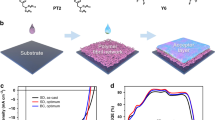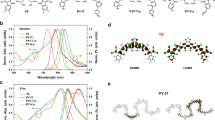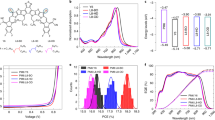Abstract
In organic photovoltaics, morphological control of donor and acceptor domains on the nanoscale is the key for enabling efficient exciton diffusion and dissociation, carrier transport and suppression of recombination losses. To realize this, here, we demonstrated a double-fibril network based on a ternary donor–acceptor morphology with multi-length scales constructed by combining ancillary conjugated polymer crystallizers and a non-fullerene acceptor filament assembly. Using this approach, we achieved an average power conversion efficiency of 19.3% (certified 19.2%). The success lies in the good match between the photoelectric parameters and the morphological characteristic lengths, which utilizes the excitons and free charges efficiently. This strategy leads to an enhanced exciton diffusion length and a reduced recombination rate, hence minimizing photon-to-electron losses in the ternary devices as compared to their binary counterparts. The double-fibril network morphology strategy minimizes losses and maximizes the power output, offering the possibility of 20% power conversion efficiencies in single-junction organic photovoltaics.
This is a preview of subscription content, access via your institution
Access options
Access Nature and 54 other Nature Portfolio journals
Get Nature+, our best-value online-access subscription
$29.99 / 30 days
cancel any time
Subscribe to this journal
Receive 12 print issues and online access
$259.00 per year
only $21.58 per issue
Buy this article
- Purchase on Springer Link
- Instant access to full article PDF
Prices may be subject to local taxes which are calculated during checkout





Similar content being viewed by others

Data availability
Source data are provided with this paper. The remaining data are available from the corresponding authors upon request.
Code availability
The codes or algorithms used to analyse the data reported in this study are available from the corresponding authors upon request.
References
Li, G., Zhu, R. & Yang, Y. Polymer solar cells. Nat. Photon. 6, 153–161 (2012).
Günes, S., Neugebauer, H. & Sariciftci, N. S. Conjugated polymer-based organic solar cells. Chem. Rev. 107, 1324–1338 (2007).
Yuan, J. et al. Single-junction organic solar cell with over 15% efficiency using fused-ring acceptor with electron-deficient core. Joule 3, 1140–1151 (2019).
Zhang, M. et al. Single-layered organic photovoltaics with double cascading charge transport pathways: 18% efficiencies. Nat. Commun. 12, 309 (2021).
Yang, F. & Forrest, S. R. Photocurrent generation in nanostructured organic solar cells. ACS Nano 2, 1022–1032 (2008).
Zhou, Z. et al. High-efficiency small-molecule ternary solar cells with a hierarchical morphology enabled by synergizing fullerene and non-fullerene acceptors. Nat. Energy 3, 952–959 (2018).
Wang, Z. et al. The coupling and competition of crystallization and phase separation, correlating thermodynamics and kinetics in OPV morphology and performances. Nat. Commun. 12, 332 (2021).
Zhu, L. et al. Progress and prospects of the morphology of non-fullerene acceptor based high-efficiency organic solar cells. Energy Environ. Sci. 14, 4341–4357 (2021).
Lorch, C. et al. Controlling length-scales of the phase separation to optimize organic semiconductor blends. Appl. Phys. Lett. 107, 201903 (2015).
Gasparini, N., Salleo, A., McCulloch, I. & Baran, D. The role of the third component in ternary organic solar cells. Nat. Rev. Mater. 4, 229–242 (2019).
Lu, L., Kelly, M. A., You, W. & Yu, L. Status and prospects for ternary organic photovoltaics. Nat. Photon. 9, 491–500 (2015).
Baran, D. et al. Reducing the efficiency–stability–cost gap of organic photovoltaics with highly efficient and stable small molecule acceptor ternary solar cells. Nat. Mater. 16, 363–369 (2017).
Gasparini, N. et al. Designing ternary blend bulk heterojunction solar cells with reduced carrier recombination and a fill factor of 77%. Nat. Energy 1, 16118 (2016).
Lu, L., Xu, T., Chen, W., Landry, E. S. & Yu, L. Ternary blend polymer solar cells with enhanced power conversion efficiency. Nat. Photon. 8, 716–722 (2014).
Yang, Y. et al. High-performance multiple-donor bulk heterojunction solar cells. Nat. Photon. 9, 190–198 (2015).
Kohn, P. et al. Crystallization-induced 10-nm structure formation in P3HT/PCBM blends. Macromolecules 46, 4002–4013 (2013).
Sepe, A. et al. Structure formation in P3HT/F8TBT blends. Energy Environ. Sci. 7, 1725–1736 (2014).
Kirchartz, T., Agostinelli, T., Campoy-Quiles, M., Gong, W. & Nelson, J. Understanding the thickness-dependent performance of organic bulk heterojunction solar cells: the influence of mobility, lifetime, and space charge. J. Phys. Chem. Lett. 3, 3470–3475 (2012).
Kirchartz, T., Bisquert, J., Mora-Sero, I. & Garcia-Belmonte, G. Classification of solar cells according to mechanisms of charge separation and charge collection. Phys. Chem. Chem. Phys. 17, 4007–4014 (2015).
Li, C. et al. Non-fullerene acceptors with branched side chains and improved molecular packing to exceed 18% efficiency in organic solar cells. Nat. Energy 6, 605–613 (2021).
Zahn, D. R. T., Gavrila, G. N. & Gorgoi, M. The transport gap of organic semiconductors studied using the combination of direct and inverse photoemission. Chem. Phys. 325, 99–112 (2006).
Zhang, M. et al. High-efficiency organic photovoltaics using eutectic acceptor fibrils to achieve current amplification. Adv. Mater. 33, 2007177 (2021).
Song, J. et al. High-efficiency organic solar cells with low voltage loss induced by solvent additive strategy. Matter 4, 2542–2552 (2021).
Cui, Y. et al. Single-junction organic photovoltaic cell with 19% efficiency. Adv. Mater. 33, 2102420 (2021).
Chong, K. et al. Realizing 19.05% efficiency polymer solar cells by progressively improving charge extraction and suppressing charge recombination. Adv. Mater. 34, 2109516 (2022).
Liu, Q. et al. 18% efficiency organic solar cells. Sci. Bull. 65, 272–275 (2020).
Song, J. et al. Morphology characterization of bulk heterojunction solar cells. Small Methods 2, 1700229 (2018).
Sangroniz, L., Cavallo, D. & Müller, A. J. Self-nucleation effects on polymer crystallization. Macromolecules 53, 4581–4604 (2020).
Oh, J. Y. et al. Self-seeded growth of poly(3-hexylthiophene) (P3HT) nanofibrils by a cycle of cooling and heating in solutions. Macromolecules 45, 7504–7513 (2012).
Liu, F., Brady, M. A. & Wang, C. Resonant soft X-ray scattering for polymer materials. Eur. Polym. J. 81, 555–568 (2016).
Wang, C. et al. Defining the nanostructured morphology of triblock copolymers using resonant soft X-ray scattering. Nano Lett. 11, 3906–3911 (2011).
Su, G. M., Patel, S. N., Pemmaraju, C. D., Prendergast, D. & Chabinyc, M. L. First-principles predictions of near-edge X-ray absorption fine structure spectra of semiconducting polymers. J. Phys. Chem. C 121, 9142–9152 (2017).
Watts, B., Swaraj, S., Nordlund, D., Lüning, J. & Ade, H. Calibrated NEXAFS spectra of common conjugated polymers. J. Chem. Phys. 134, 024702 (2011).
Zhong, W. et al. Decoupling complex multi-length-scale morphology in non-fullerene photovoltaics with nitrogen K-edge resonant soft X-ray scattering. Adv. Mater. 34, 2107316 (2021).
Collins, B. A. et al. Polarized X-ray scattering reveals non-crystalline orientational ordering in organic films. Nat. Mater. 11, 536–543 (2012).
Liu, F. et al. Relating chemical structure to device performance via morphology control in diketopyrrolopyrrole-based low band gap polymers. J. Am. Chem. Soc. 135, 19248–19259 (2013).
Bakulin, A. A. et al. The role of driving energy and delocalized states for charge separation in organic semiconductors. Science 335, 1340–1344 (2012).
Rao, A. et al. The role of spin in the kinetic control of recombination in organic photovoltaics. Nature 500, 435–439 (2013).
Yu, Z. M. et al. Molecular helices as electron acceptors in high-performance bulk heterojunction solar cells. Nat. Commun. 6, 8242 (2015).
Sandberg, O. J., Tvingstedt, K., Meredith, P. & Armin, A. Theoretical perspective on transient photovoltage and charge extraction techniques. J. Phys. Chem. C 123, 14261–14271 (2019).
MacKenzie, R. C. I., Shuttle, C. G., Chabinyc, M. L. & Nelson, J. Extracting microscopic device parameters from transient photocurrent measurements of P3HT:PCBM solar cells. Adv. Energy Mater. 2, 662–669 (2012).
Xiao, B. et al. Relationship between fill factor and light intensity in solar cells based on organic disordered semiconductors: the role of tail states. Phys. Rev. Appl. 14, 024034 (2020).
MacKenzie, R. C. I. General-Purpose Photovoltaic Device Model (gpvdm) https://www.gpvdm.com. (2011).
Wang, C., Dong, H., Jiang, L. & Hu, W. Organic semiconductor crystals. Chem. Soc. Rev. 47, 422–500 (2018).
Lai, H. & He, F. Crystal engineering in organic photovoltaic acceptors: a 3D network approach. Adv. Energy Mater. 10, 2002678 (2020).
Zhu, L. et al. Efficient organic solar cell with 16.88% efficiency enabled by refined acceptor crystallization and morphology with improved charge transfer and transport properties. Adv. Energy Mater. 10, 1904234 (2020).
Acknowledgements
This work was financially supported by the National Natural Science Foundation of China (grant nos 51973110, 21734009, 21905102, 51825301, 21734001 and 22109094), the National Key R&D Program of China (grant nos 2020YFB1505500 and 2020YFB1505502), the Program of Shanghai Science and Technology Commission’s Science and Technology Innovation Action Plan (grant nos 20ZR1426200, 20511103800, 20511103802 and 20511103803), the Natural Science Foundation of Shandong Province (grant no. ZR2019LFG005), the Key Research Project of Shandong Province (grant no. 2020CXGC010403) and the Center of Hydrogen Science, Shanghai Jiao Tong University, China. J.N. and J.Y. thank the European Research Council for support under the European Union’s Horizon 2020 research and innovation programme (grant nos 742708 and 648901). We thank C. Wang and C. Zhu from the Advanced Light Source for providing X-ray scattering tests, which were carried out at beamlines 7.3.3 and 11.0.1.2 at the Advanced Light Source, Molecular Foundry, Lawrence Berkeley National Laboratory, supported by the US Department of Energy, Office of Science, Office of Basic Energy Sciences.
Author information
Authors and Affiliations
Contributions
F.L. and Y.S. conceived and directed this project. L.Z. fabricated and characterized the organic photovoltaic devices. L.Z. and M.Z. conducted the certification. J.X. processed and analysed the single-crystal data. C.L. synthesized L8-BO. M.Z. and T.H. carried out the transient photovoltage, transient photocurrent and impedance characterizations and analysed the data. G.Z. and H.Z. provided the transient absorption spectroscopy results and corresponding analysis. W.Z. carried out the GIXD and RSoXS measurements and assisted with data analysis. J.S. conducted the AFM measurements. J.Y., R.C.I.M. and J.N. conducted the drift diffusion simulation and analysis. Y. Zou conducted the TEM measurements. Y. Zhang, X.X., Z.Z. and R.Z. contributed to the fruitful discussions of this project. L.Z. and M.Z. wrote the manuscript, and C.-C.C., J.Y., R.C.I.M., J.N., Y.S. and F.L. contributed to revisions of the manuscript. This manuscript was mainly prepared by F.L., Y.S., L.Z., M.Z. and J.X., and all authors participated in the manuscript preparation and commented on the manuscript.
Corresponding authors
Ethics declarations
Competing interests
The authors declare no competing interests.
Peer review
Peer review information
Nature Materials thanks the anonymous reviewers for their contribution to the peer review of this work.
Additional information
Publisher’s note Springer Nature remains neutral with regard to jurisdictional claims in published maps and institutional affiliations.
Supplementary information
Supplementary Information
Supplementary Figs. 1–49, Tables 1–21, Notes 1–11, Materials and Methods, and references.
Supplementary Data 1
Statistical source data for Supplementary Tables 15–17.
Source data
Source Data Fig. 1
Statistical source data.
Source Data Fig. 5
Statistical source data.
Rights and permissions
About this article
Cite this article
Zhu, L., Zhang, M., Xu, J. et al. Single-junction organic solar cells with over 19% efficiency enabled by a refined double-fibril network morphology. Nat. Mater. 21, 656–663 (2022). https://doi.org/10.1038/s41563-022-01244-y
Received:
Accepted:
Published:
Issue Date:
DOI: https://doi.org/10.1038/s41563-022-01244-y
This article is cited by
-
High-efficiency flexible organic solar cells with a polymer-incorporated pseudo-planar heterojunction
Discover Nano (2024)
-
Selenium substitution for dielectric constant improvement and hole-transfer acceleration in non-fullerene organic solar cells
Nature Communications (2024)
-
Rational molecular and device design enables organic solar cells approaching 20% efficiency
Nature Communications (2024)
-
Perovskite–organic tandem solar cells
Nature Reviews Materials (2024)
-
The role of interfacial donor–acceptor percolation in efficient and stable all-polymer solar cells
Nature Communications (2024)


